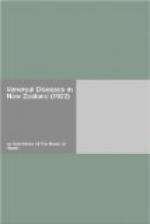Sufficient instruction should be given to adolescents regarding venereal diseases and their effects to ensure that if they do contract them it shall not be through ignorance. The Committee cannot too strongly emphasize their belief, however, that knowledge of the effects of venereal diseases is in itself by no means a sufficient safeguard; that in addition to such knowledge the cultivation of a high moral standard is necessary, and if this is reinforced by religious sanctions it is likely to be more effective.
The Committee agree with the view expressed by Dr. E.T.R. Clarkson in a recent text-book, entitled “The Venereal Clinic,” that in many instances an excessive stress has been placed upon the factor of fear. He says that a very small proportion of the community are restrained from indulging in promiscuous sexual intercourse through fear, and it is irrational to rely so much upon an emotion which at the best is but slightly inhibitory, and which cannot in itself exercise a direct energizing influence for good. “We do not,” he continues, “wish to deter the community from living a life of sexual promiscuity by rendering them fearful of the possibilities of acquiring venereal disease, but we want rather to instil such an ideal into them, whether it be of a religious, ethical, or altruistic nature, as will tend to make them regard such a life as incongruous with those tenets and therefore as undesirable, however much it may be desired on other grounds.” He adds that the emphatic reiteration of fear possesses another and dangerous disadvantage. “There is no doubt, as venereologists will testify, that many individuals are seriously suffering from the effects of fear thus engendered in their minds. In some instances the resultant damage to their mentality is more serious than the venereal disease from which they are suffering: whilst in others an obsession that they are infected, when there is no foundation for the fear, may develop in such a manner as to inflict serious and permanent damage.”
SECTION 2.—CLINICS FOR THE TREATMENT OF VENEREAL DISEASE.
Early in 1919 clinics for the treatment of venereal disease were established in each of the four main centres. Arrangements were made by the Department of Health for the treatment by Hospital Boards throughout the Dominion of cases of venereal disease, and in the absence of local institutions arrangements were made with private practitioners. There is therefore opportunity for all to receive free treatment, wherever they may be, in New Zealand.
Table B sets out the work done at the four clinics during the two and a half years ended 30th June, 1922. From this table it will be seen that 3,038 males and 596 females attended these clinics during the period named. The total number of attendances was 110,792—101,995 males and 8,797 females. The disproportion between the number of males and females attending is notable. It is clear from the evidence that this does not represent a difference in the incidence of these diseases in the sexes, but that women do not attend so freely when suffering.




